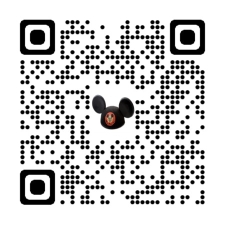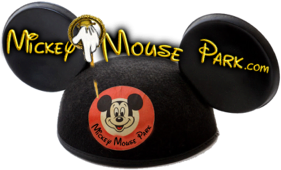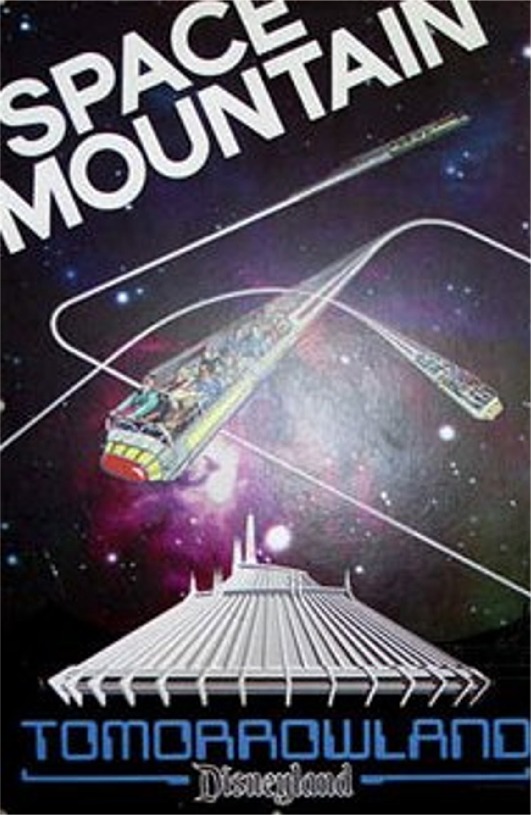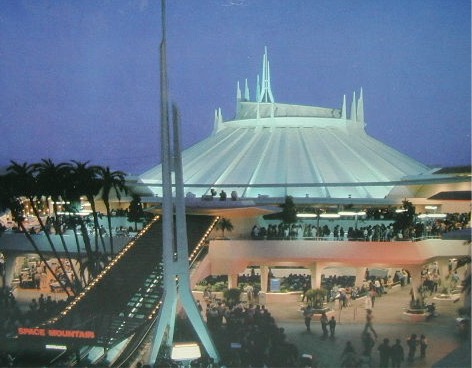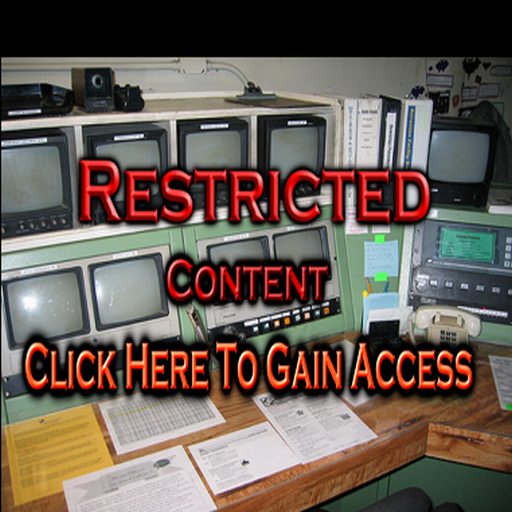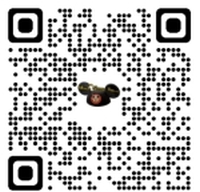
One early plan for the original Space Mountain had rockets orbiting the mountain on the outside, then "plunging into the blackness of space" inside. The original design was done by 1966, and got Walt's blessing, but there wasn't a control system available then that could operate it safely. By 1975, there was -- thanks in part to RCA sponsorship. This control system involves weighing each car, and considering its rolling qualities on its previous trip; which input is used to compensate for variations in passenger weight, wear, and even the different rolling qualities of the nylon wheels as they warm up over the day. Given these inputs, Space Mountain can dispatch rockets more frequently without concern for collisions -- up to eleven rockets.
The computer cannot slow rockets down inside the mountain. The only way to prevent one rocket from catching a lighter one in front of it, is to delay the rocket from entering into the mountain as much as possible. If the delta for the weight is greater than 600lbs. the computer will delay the rocket for 4 seconds. But if the weight is greater than 800lbs. the "tower" cast member must delay the rocket longer, as much as possible. If one rocket does catch up to another, this causes a "brake zone intrusion" and a ride cascade stop occurs.
Two PLCs (Programmable Logic Controllers) report to the computer, using electronic sensors to monitor the location and speed of each vehicle.
Some info supplied by: Kory Blankenship Garden Grove, CA
Statistics:
Roller coasters almost never travel at the exact same speed. They tend to speed up as the day goes on and the parts warm up. Also, the weight of the passengers affects the speed dramatically. Space Mountain features a soundtrack in each individual train that is able to locate its position on the track. This keeps the music in sync with the ride despite the trains speed.
Construction started: June 1975
Construction ended: May 1977
Opening Ceremony: May 27, 1977
Building Diameter: 200 ft.
Height: 75 ft (excluding external spires) 117 ft (ground level to top spire) 17 ft below grade
Length of track: Approx. 3,450 linear feet, including ride track, storage track and spur track
Length of ride: 3,035 ft. or .57 mile
Number of vehicles: 13 rockets, 2 vehicles per rocket
Vehicle capacity: 12 passengers
Average speed: 11.21 mph
Maximum speed: 30.2 mph
These US Mercury Astronauts people were in attendance on May 27,1977:
Scott Carpenter
Wally Schirra
U.S. Senator John Glenn
Betty Grissom, widow of Virgil Grissom
Gordon cooper
Alan Shepard
Donald Slayton
Voices:
Wendy Beryllium - Kelly Caufield
Ray Cathode - Glenn Shadix
Crazy Larry - Charles Fleischer
The soundtrack, "Aquarium" from Saint-Saens' "Carnival Des Animaux," is played by 1960s surf guitar legend Dick Dale.
From Steve Birnbaum brings you the best of Disneyland 1982:
Without a doubt one of the best attractions in the park and certainly one of the most popular, Space Mountain must also rank among the best roller coasters in existence. its greatness derives not so much from the fact that it will leave your stomach behind as from the fact that most of the trip takes you shooting through pitch blackness with stars whizzing by on all sides. It's an experience so splendid and magical that it can be enjoyed many times without any disappointment. It's not a rocket journey, really: The twelve- passenger "rockets" are similar to those boarded by many a roller-coaster buff, with two-abreast seating, and the ride's route is traveled at the relatively moderate speed of about 32 miles per hour. But between the stars and the Cosmic Vapor Curtain and the Solar Energizer and the glowing nebula, the attraction boasts such beauty that it's not hard to understand why Southern Californians queued up for as long as two hours to experience it when it first opened. (Though the situation isn't nearly so bad nowadays, it still behooves a queue hater to make a beeline for the mountain immediately upon arriving in the park.) Such a marvel doesn't develop overnight, Walt Disney had the idea for the attraction early in the park's history-long before the technology to operate it had been developed. The original sketch for the many-spired white cono, not all that different from the present structure, was drawn in 1964 by John Hench (whose name appears on the Main Street window above Carefree Corner). Subsequently, workers representing around 150 different crafts and specialties put almost a million man- hours into the design and construction of this bit of man-made mountain magic. It took nearly two years to construct, and the whole thing is sunk 15 feet into the ground-so as not to dwarf Sleeping Beauty Castle or the Matterhorn. Pregnant women, children who are under three or less than 40 inches tall, and other guests who suffer from weak backs, heart conditions, motion sickness, and other physical limitations are not permitted to ride. Children under seven must be accompanied by an adult. Those who don't normally enjoy roller coasters should be sure to ride the PeopleMover, which offers a look at the scenic wonders inside the mountain. Those who decide they might want a still closer look should line up with the brave at the base of the Speedramp. Note that if you get cold feet once inside the mountain, there are three "chicken exits" in the queue area en route to the loading dock-one just past the en- trance to the building, another farther along by the turnstiles, and the last right at the loading area. Parents can wait with their youngsters until this final exit and rendezvous at the exit after the ride is over.
In April 2003 a major refurbishment of Space Mountain was started..Space Mountain will be redesigned and relaunched in conjunction with the Disneyland 50th Anniversary in 2005.
Space Mountain reopened in July 2005
After 2003-2005 refurbishment the on board music was composed by Michael Giacchino
Rockin' Space Mountain during the promotion's run, with Red Hot Chili Peppers 1989 cover of Stevie Wonder's "Higher Ground" accompanying riders as they soar through the ride's virtual outer space setting.

 Click Here To Gain Access
Click Here To Gain Access
 Click Here To Gain Access
Click Here To Gain Access
 Click Here To Gain Access
Click Here To Gain Access
 Click Here To Gain Access
Click Here To Gain Access
 Click Here To Gain Access
Click Here To Gain Access
 Click Here To Gain Access
Click Here To Gain Access
 Click Here To Gain Access
Click Here To Gain Access
 Click Here To Gain Access
Click Here To Gain Access
 Click Here To Gain Access
Click Here To Gain Access
 Click Here To Gain Access
Click Here To Gain Access
 Click Here To Gain Access
Click Here To Gain Access
 Click Here To Gain Access
Click Here To Gain Access
 Click Here To Gain Access
Click Here To Gain Access
 Click Here To Gain Access
Click Here To Gain Access
 Click Here To Gain Access
Click Here To Gain Access
 Click Here To Gain Access
Click Here To Gain Access
 Click Here To Gain Access
Click Here To Gain Access
 Click Here To Gain Access
Click Here To Gain Access
 Click Here To Gain Access
Click Here To Gain Access
 Click Here To Gain Access
Click Here To Gain Access
 Click Here To Gain Access
Click Here To Gain Access














